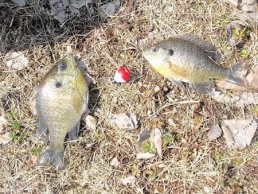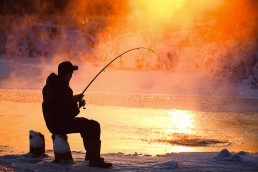Open-water Fishing in January? Are You Nuts?
SHARE THIS POST
Well, no one ever said that fishermen are completely sane, and truth be told, those of us who “like” to fish during the winter are perhaps the nuttiest of all. However, every January finds me watching The Weather Channel hoping for a warm spell that will put a temporary melt to the hard water on the nearby ponds.
Don’t get me wrong, for I enjoy ice fishing and do quite a bit of it. But it wasn’t for nothing that January was named after Janus, the two-faced Roman god. Predictably, the second or third week of this month will find a warm wave of air coming up from the south, bringing with it unseasonably warm temperatures lasting for several days and sometimes even a week. The ice melts, at least partially, on the ponds where I like to fish—and the fish begin to bite.
Yes, it is true that these same fish have been biting right along through the holes that I drilled, but now with open water I don’t have to drill, I can just cast.
You don’t think the fish will bite? You are incorrect. The water was never colder than when it was covered with ice, so why do they bite?
Open water brings a slight rise in the surface temperature of the water, as well as a fresh influx of oxygen. This in turn spurs the growth and movement of plankton, which in turn stimulates a feeding urge in the tiny baitfish. When the baitfish go on the move, the larger predators sense an easy meal. Their metabolism speeds up slightly by the warmer water and the increased sun penetration. This is the time to be on the water—but just not anywhere.
Are you enjoying this post?
You can be among the first to get the latest info on where to go, what to use and how to use it!
Warmer air is accompanied by stiff breezes, which can chill the body, but not the soul of a die-hard angler. Face into the wind; that is the side of the pond where the fish will be. Contrary to conventional wisdom, the wind does not blow fish into the shallows, but rather the wave action stimulates the movement of plankton and sets the whole feeding frenzy into action.
Making a cast into the wind is never pretty. I just lob a waxworm- or red worm-baited hook below a weighted bobber into about 6 feet of water and wait for a bite. For some reason I cannot explain, I never have to wait very long. If the fish are there, they hit it. If not, try 2 feet to the right or left. Vary the distance of the cast, the depth of the hook, your areas for the clarity of the water, etc., until you find the fish.
Once found, expect the school to bite well for a few minutes and then quit. What happened? The school moved. I actually have followed the movements of a particular school of fish from one part of a pond to another by casting, getting a few strikes and then getting nothing until I moved the bait.
Bluegills are the target, of course. But crappies and largemouth bass will often be eager biters during this short fishing spree. Frequently, February and March will offer just as productive open- water fishing as January.
The opportunities are great for those who venture forth. Be sure to dress appropriately, take along a Thermos of warm liquid, a chair, a bucket for the catch, a pair of shades and a camera. And, tell someone where you will be and how long you expect to be there. Again, most importantly, never venture out onto unsafe ice. Fish from the shore, keep what you need to eat and throw back the rest.
MWO
SHARE THIS POST
Did you enjoy this post?
You can be among the first to get the latest info on where to go, what to use and how to use it!
John Bennett
John Bennett is a retired history teacher, historical re-enactor, father and grandfather. As a four-season outdoorsman, his passion is waterfowl hunting and fishing for smallmouth bass. He lives in Ohio and spends quite a bit of time in his primitive log cabin, which he built.



